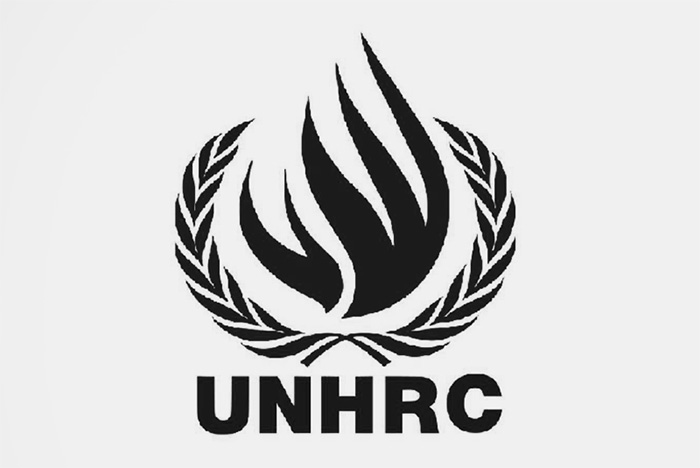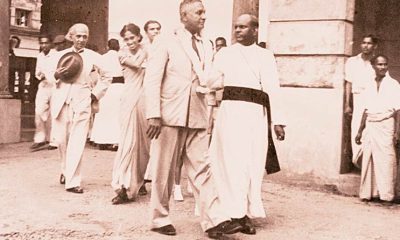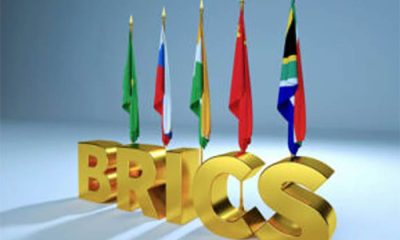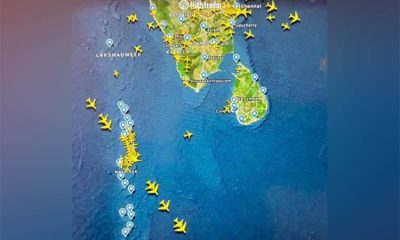Opinion
Economic benefits of Basil’s India visit

By TENNEKONE RUSIRIPALA
Events become more important and focused in the context of their after effects. Criticism leveled beforehand will only be conjecture yet to become realities. Diplomatic initiatives demonstrate how a small neighbor state can successfully move towards a pro-active bilateral relationship, interacting with other countries in the neighborhood OR even in the region, within the confines of available economic space.
Finance Minister Basil Rajapaksa’s move to initiate a dialogue with our Immediate neighbour India, is an extremely wise and timely move, in keeping with the important components of governance and principles of diplomacy. This is so, considering the essential need for re-affirming the mutual trust between the two states, and how a nation could act with a drive to become relevant, influential and acceptable in its bilateral relations with another big country, specially when the latter is playing a significant role in quickly transforming itself into a fast growing nation in the global scenario. It appears that the move and the conclusions reached awaiting finalization, is a disposition of trust and confidence vital for the mutual national interests of both countries.
The growing economic strain we are experiencing right now is compelling us to look for immediate relief measures, to seek remedies which do not affect our core interests due to interactions with powerful players. The choice of non-controversial scopes is also an important factor being mindful of the credibility issues, and long term effects while addressing short term relief as a priority in such accords. Let us now examine the areas of concern and the basis of understanding to be reached, as already announced in a media release about the Finance Ministers proposals from our side. It also has to be acknowledged that this early release of the relevant information will dispel any skepticisms and avoid misrepresentations and distortions.
I. Food and health security package on an urgent basis that would envisage the extension of a line of credit to cover the import of food , medicines and other essential items from India to Sri Lanka.
It needs no emphasis to explain the essential nature of food imports from India to our day- to- day food requirements. India has been a main source for several items of a staple nature over a long period, and any disturbance to this line of supply will be critical to the daily routines of our people. Sri Lanka’s Trade Share with India alone is approx.. 2.5 Billion US $ per year. Food items and medical supplies largely account for our imports from India. Funding imports is a problem due to the prevailing depleted balances in our foreign exchange resources. Hence, the negotiation of a facility on extended payment terms for the (imported) supply of these items becomes extremely important, to prevent any shortfall or disruption in the supply of essential drugs and consumer food items.
ii .Energy Security Package that would include a line of credit to cover import of fuel from India , and an early modernization of Trincomalee tank farm Fuel and Energy are so vital to our day to day lives. We do not have any access to Crude Oil supplies or refined Oil, other than importing them. Our annual Fuel Import Bill is averaging between US$ 3800 to 4000 million.
A day’s black out in the supply of Electricity in the country, which we experienced very recently, indicated how essential it is to have a smooth supply of uninterrupted electricity supply. Besides, the denial of the luxuries of air-conditioning , instant lighting, lift-systems, building escalators; we saw the water supply too getting affected in certain areas raising alarm signals. Hospitals, operation theaters and even traffic light signals were disturbed. While the public cannot condone any action upsetting their daily routines, the power failure signaled a severe warning to all about the need to run it as an essential Public Service. Fuel is a predominant factor playing an important part in the energy supply equation.
In a situation where our Reserve balance has gone below 1.4 Billion US$, we have to take adequate safeguards in maintaining the supply position, considering it as a national priority.
The Finance Minister’s choice of approaching India becomes appropriate due to many reasons, particularly to address our fuel issue with Indian support. The two countries already have an ongoing business relationship in the field of fuel supply in the country. India is very advanced in the Oil Refinery industry and it is interesting to examine their involvement in the Fuel Industry.
Petroleum refining
With a total refining capacity of 69.2 million tons per year, the state-owned Indian Oil Corporation was the largest refiner in the country by capacity. Indian Oil’s refineries processed 69.001 MMT of crude oil in 2017–18.
In September 2021 the total installed capacity of the Oil Refinery Industry stood at 246.9 million metric tons and their Crude Oil production was 32.2MMT in addition to their importing volume of 4.54 Million barrels.
India aims to commercialize 50% of its strategic petroleum reserves to raise funds and build additional storage tanks to offset high oil prices. This gives a clear picture of the Oil Industry of our neighboring country. There is a big potential arising out of the need to increase their Crude Oil storage facilities.
And this provides an ideal opportunity to put into best use of our Gold valley in the form of a dormant Oil Tank Farm, located in a unique strategic geographical positioning in Trincomalee.
There is a strong possibility for a highly win-win situation for both countries to gain advantages from a suitable agreement.
Sri Lanka should use all its bargaining skills to enter into an agreement, where the price fluctuations of Oil Products is given due consideration, for both countries to share the benefits in a fair manner, with due weightage given to our sovereign ownership of the golden property.
At this moment I recall the Rubber /Rice agreement we reached many years ago and the basic concepts and principles underlying that agreement, such as the consideration of a discounted price for the rice on account of the exclusive supply arrangement we tied ourselves into. In a similar gesture, our Oil tanks could be the pivotal focus for a special price for our domestic consumption requirements of fuel.
iii. Offer of a Currency Swap to help Sri lanka address the current balance of payments issues;
India has given us such support and help several times, and with the economic package that is in the center of the negotiations it will not be difficult for the Reserve Bank to consider this in our favor.
iv. Facilitating Indian Investments in different sectors in Sri Lanka that would contribute to Growth and expand employment.
This will build on recent trends in that respect.
We have to recognize the technological advancement India has made both in the fields of Industry and Agriculture, helping them to a high position of placement in the order of GDP growth rates, occupying the highest place in Asia. Their experience, progressing technical advancement, closeness of our Geographic locations, in addition to our traditional, historic and cultural relations will be to the mutual advantage of both countries, to be taken into seriously in reaching an accord. There are several areas of harnessing the resourcefulness of both countries to share the values in offering unique services in many fields hitherto unexploited.
All these will no doubt pave the way for a rational settlement of any minor prickly issues that we may have had between the two countries due to geo-political alienations. Nevertheless, we have continued our relationship with India all these years with a history of sacrifices, and commitment each country has extended on many controversial issues. Sri Lanka’s involvement during the period of Mrs. Sirimavo Bandaranaike to intervene in the Indo-China conflict, our accords with India on the Migrant Indian labour, and Kachchativu island matter are memorable milestones in this regard.
We look forward to a successful conclusion of the MOU reached following the visit of Minister Basil Rajapaksa, and hope for its best outcome to the mutual satisfaction of both countries.
Opinion
Towards a more profitable and sustainable agriculture

BY Upatissa Pethiyagoda
One of the key happenings in human history, is the so-called “Industrial Revolution,” that originated about two centuries ago, with Europe, North America and Japan, as the focal points. These are now broadly defined as “Developed Countries.” They distinguish themselves as having higher per capita incomes, and thereby offering their citizens better living conditions than do the ‘developing’ or ‘less developed’ ones.
It is tempting yet erroneous, to believe that what prevailed two centuries ago, can be transposed today to other countries including Sri Lanka, presently classified among the “Developing countries.”
Typically, the industrial era manifested as a movement away from labour and towards machinery driven enterprises. The unspoken assumption is that what worked for them then, should do for us now.
This is a presumption that is unlikely to happen. Although a small Tropical country within the Monsoon belt, we are fortunate in being generally spared weather-related atmospheric perturbations such as hurricanes, cyclones and tsunamis, which assail other similar sized countries and locations.
Overall, we are also fortunately blessed with largely favourable climatic conditions and reasonably fertile soils, to ably support a sustainable, diversified and a seemingly unique mosaic of farming, livestock and forestry. This is worthy of protection.
By virtue of our geography, climate, tradition and aptitude, we are well positioned to be a dominant base for a vibrant Agrarian Economy. A composite of the sectors associated with plants and animals, best suits our natural strengths. This leads us logically to seek economic advancement through this sector, with a blend of farming, livestock and forestry, to best support environmental stability as our long-term goal.
Two factors that are poised to impact on Worldwide agriculture, are “global warming” and a looming “water crisis.” These will affect different regions with differing severity. These possible hazards have aroused much International concern. Sri Lanka would do well to prepare itself for these eventualities.
In the particular context of Sri Lanka, the major concerns would lie in the agrarian, forestry, fishery and environmental sectors. The focus for close and timely attention include the following:
(i) Correcting weaknesses in the Extension Services which are primarily blamed for under- performance. All officers concerned in the above sectors, would benefit from periodic exposure to training that is designed for upgrading knowledge and sharpening requisite skills.
(ii) The Sri Lankan Agricultural Sector divides itself into two components, namely, the Export and Local Crop sectors. Animal farming is set apart, and historically has received less attention. However, the recently expanding poultry industry has resulted in greater attention to livestock expansion.
(iii) In Ceylon’s colonial history, it was the British who eventually exercised their sovereignty over the whole country, succeeding the Portuguese and Dutch, who were confined to the coastal regions. Cinnamon was the first crop that attracted the colonisers, followed sequentially by Cinchona (Pyrethrum, on a small scale) and Coffee. In the 1840s, the invasion by the Coffee Rust (Hemileia vastatrix), laid waste to the Coffee plantations. Tea took over and rapidly expanded, mainly by encroaching into Highland Forest areas. Little attention was given to environmental and social consequences. Meanwhile, rubber plantations dominated in the wetter Lowlands. A while later, attention was directed towards Coconut.
(iv) Research Institutes – TRI, RRI and CRI were established to cater to the needs of the fast developing Plantation Crops.
The introduction of Plantation Crops had far-reaching and lasting Economic, Political, Social, Environmental and Cultural consequences. The more recently established Minor Export Crops, (renamed as The Export Crops Sector) mainly services the Spice Crops – Cinnamon, Pepper, Nutmeg and Cardamom. Also Cocoa and Coffee. Sugar, Cashew and Palmyrah are crops that are developing their own support structures.
(v) All others are catered for by the Department of Agriculture, whose main efforts are understandably focused on the Paddy sector. This is a sector that had received scant attention from the colonial British, who had an understandable preference for importation of rice from their colonial Burma and Thailand.
(vi) The cleavage (into export and local sectors), while having several operational advantages, also created problems. Seriously, the result is an inequality in resources (most notably in the matter of qualified staff) and consequent waste.
A major problem in consolidation and improving the services of research and extension arises from differences in the sources of funding. The TRI is funded entirely by a cess on exports, while the Departments of Agriculture and Minor Export Crops are dependent entirely on the government, and the RRI and the CRI by a mix. This has resulted in big differences in staff strengths and organisational complications. There are thus an under-utilisation of staff, facilities and distorted priorities.
(vii) The tea industry in its early expansive phase, relied heavily on indentured labour from South India. This coupled with the unjust expropriation of lands belonging to locals, particularly those of the Kandyan peasantry, and the ecological damage by unrestricted invasion into forest areas in the central hills, has created seething resentment and ecological harm. The massive importation of South Indian labour, particularly in the expansion phase of the tea industry, have resulted in social, economic and political complexities prevailing even now. This is still a silent concern.
(viii) Since it is impossible to balance the requirements and production of agricultural produce, scarcities and gluts are not uncommon. Scarcities are met by imports, while surpluses largely result in waste. This can be as high as 35% in the case of perishable vegetables and fruits.
This is a colossal loss. It is scarcely possible to point to a single agronomic practice that can provide a similar return. Thus, if such losses can be limited or eliminated, the impact will be considerably greater than any improvement in agronomic practice. This must be a binding pre-requisite for a sustainable agriculture. Quality improvement begins with timely harvesting, minimising bruising, exposure to light and heat, packaging and transport. Models are available for delicate or vulnerable products (e. g. Bananas and Cut Flowers) that could offer hints of what procedures and facilities such as “Cold Chains” are necessary or feasible.
(ix) To deal with product surpluses, obvious remedies include providing better storage facilities with protection from insects, fungi, rodents and other marauders. Such storage could suit Paddy, maize, pulses, peanuts and some fruits. In the case of vegetables, many fruits and other perishable produce, post-harvest handling and transport are key needs. Where appropriate, preservation by simply drying (by Sun, ovens or other equipment), freezing, canning, bottling and packaging are means of coping with surpluses and in most cases, also as a means of value addition.
These are the considerations paramount in developing a profitable and sustainable Agriculture – which will continue to play a key role in the National Economy. The focus should change to an Agriculture prioritizing Food Security, import substitution and improvements of farmer livelihoods.
(x) Land Use. Hitherto, the agricultural services have been “crop based”, largely for historical reasons. By far, a change to an emphasis on a “Land use” paradigm, would be logically, economically and environmentally more sound. Despite the inconvenient financing and logistics issues, on balance, the benefits in the long term will decidedly outweigh the initial effort.
(xi) Agricultural Shows offer great opportunities to track and procure genetically superior cultivars for multiplication. This will play a vital role. Technologies evolved in Home Garden and Plant House efforts are obvious sources of new knowledge and practices.
(xii) A persistent problem in Colonization Schemes is to retain, support sustainable cropping patterns, capable of sustainable livelihoods. The common tool is to provide Model Units to combine crop, livestock, pastures, and Forestry, with choices and production designs and “mock-ups” for different sizes of land allocations.
(xiii) “Going organic” is certainly much superior in maintaining soil fertility, reducing erosion, and supporting more favorable conditions for maintaining the soil biome (bacteria and earthworms), mitigating ill effects of continuous reliance on chemicals for nutrient needs, weed-killers and pesticides. A soil devoid of its natural diversity is effectively dead and in its sterility becomes a mere unsustainable anchoring medium.
(xiv) In our particular case, there is an alarming decline in fertility and increase in soil erosion, resulting from heavy and long term application of artificial fertilizers (especially ammonium sulphate for tea). A total and objective and unbiased intervention, to examine the costs (including maintenance and “opportunity cost”) and returns. This may result in surprising revelations but need not deter a re-evaluation.
Opinion
UNHRC faux pas: BRICS yet another!

Tamara Kunanayakam deserves the gratitude of all Sri Lankans concerned by the machinations of US and its allies, for the excellent commentary titled “UNHRC resolution, good governance, BRICS – Operation camouflage?” (The Island, 11 November). She is an experienced diplomat and was the Permanent Representative of Sri Lanka to the United Nations Office at Geneva from 2011. She successfully defended Sri Lanka at UNHRC when the process of passing resolutions against Sri Lanka started.
While the odd behaviour of the government regarding BRICS, which she had gone into detail in her piece, was very much in the news, what she stated about the UNHRC resolution focuses on the intentions as well as capabilities of the JVP/NPP government. This coming from a person with intimate knowledge of the workings of the UNHRC, gives added weight.
Vijitha Herath, the government spokesman’s declaration that the UNHRC resolution drafted by USA/UK and presented to the council by the UK was ‘strongly rejected’ by the government got wide coverage in the media. However, what followed was hardly mentioned and I was surprised and taken aback by the following paragraphs in her commentary:
“Nevertheless, on that same day, the resolution that the Government had “strongly” rejected was adopted without a vote, i.e., by consensus, and consensus resolutions necessarily involve the explicit or implicit consent of the country concerned.
Had indeed the Government “rejected” the external mechanism, it would have called for a recorded vote, the only way to prevent consensus on a hostile draft. Being a non-member state, it would have had to request a friendly country to act on its behalf, and Cuba, China and Pakistan have always obliged. Without a specific request from Sri Lanka, no country that respects the principle of state sovereignty and the right of peoples to self-determination would have called for a vote. It is evident that that request never came. By the decision not to call for a vote, the Government did the opposite of what it had said it would do, even reversing Sri Lanka’s previous rejection of the mechanism at the Council’s 2021and 2022, and consenting to its establishment as well as extension.”
This action of the government raises very significant issues. Was this lapse, if indeed it was, due to inexperience? Or, has the faux pas exposed the sheer incompetence of this government? Worse still, is this government also run by a Viceroy?
Perhaps, as she alludes to, it is an ‘operation camouflage’
Dr Upul Wijayawardhana
Opinion
Valuation Department – a sick giant in deep slumber

Seventy-nine months – six years and seven months – for a file to be cleared by the slack officers in the Valuation Department. Finally, after much effort, in June 2023, a lady officer was cajoled to look into it. The file that was in hiding was retrieved from some deep dungeon and a clerk was directed to work on it. In July 2023, the completed file was sent to the Divisional Secretariat, Kotte. The formal valuation was sent to me – and I detected a serious error in the valuation as the extent of my land given in the document was totally erroneous. Surveyor General official document following surveying the land in 2017, has certified my ownership as 0.0337 HECTARES.
(1 HECTARE IS EQUAL TO 395.3686 PERCHES)
On this basis, the extent of my block of land is 13.3239 PERCHES.
This is the only block of land I own. It is situated off Temple Road in the vicinity of the Open University. I was notified that it had been earmarked for acquisition for Flood Control Project Development purposes by the SLRDC. For the valuation that has to precede the granting of compensation for my land, I had to go through formalities such as repeatedly surveying the land, obtaining legal documents to prove my ownership and several other documents and information connected with it. These procedures have cost me a large sum of money as well as time and hard work. After several months of tedious labour running from pillar to post, SLRDC was satisfied that the requirements are in order.
SLRDC SENT DOCUMENTS TO VALUATION DEPARTMENT IN 2018
Thereafter, the documents were sent from SLRDC to the Valuation Department on January 2nd 2018—more than 6 years ago. The file has been lying on the desk of an officer through all these months. When inquiries were made in 2020 from time to time the officer dealing with my file was habitually late for work, not in her seat, absent for days due to illnesses like ear ache, etc. These were the frivolous excuses given for not attending to my file. She is currently transferred to an office in Maharagama.
Three reminders were sent by SLRDC to Valuation Department to expedite the valuation. Yet, the reminders were totally ignored.
Valuation Department after a very long period of 79 months, has woken up and has sent a valuation that shows the extent as 0.0337 PERCHES with a value stated as Rs.100,000 for the entire extent of 13.3239 Perches. This valuation is totally erroneous and quite suspicious as there seems to be a sinister move to put me off the track and carry out some underhand dealing. Where would anyone get even ONE perch of valuable land in Nawala for that amount?
This is a fraudulent valuation. My file was kept in hiding for over 6.5 years from 02 January 2018 to July 2023. I have been constantly trying to make the Valuation Department work on it – writing to them numerous letters, appeals and personally trying to meet the relevant officers but to no avail. I sent a formal complaint to the Chief Valuer. Never did I receive a response. This is the extremely slack, careless and inefficient manner in which the officers of the Valuation Department discharge their duties. This Department that handles money worth millions needs to be fully overhauled and the entire officers from top to bottom need a thorough cleansing. It is a hell hole of corruption.
I am writing this with great pain of mind and utter disappointment regarding the unexplained huge delay and final careless and fraudulent valuation that is being awarded to me. I am certainly not prepared to accept this minuscule award.
I was also notified that in the event that I do not accept the decision, I could appeal to a Reviews Board. I sent my appeal promptly under registered cover to the Reviewing Board in September 2023. In my appeal I stated that nowhere in the vicinity of Nawala so close to the Open University and other strategic places could one buy even one perch of land for Rs.100,000. This undervaluation shows some hidden agenda which I am certain of. The extent shown on the official valuation is incorrect. It is NOT .0337 Perches BUT .0337 HECTARES.
There are houses alongside mine and professionals residing in the adjoining blocks; this being a highly residential area in the heart of the city. My land has some trees and vegetation. At some moment in time, former president Gotabaya Rajapaksa had in a high-handed manner and without my knowledge or approval dug a trench across my land and another block bordering mine.
Since my appeal to the Reviewing Board, one year has also gone by and the appeals officer also is in deep slumber. I called a few times to see if the matter is being attended to and was vaguely told that they have sent it to SLRDC, Kotte for some further information. When I contacted SLRDC, I was told that the information had been sent promptly. Appeals section lady officer gave vague answers when called again. She is still silent. One does not know who is lying. These are state officials entrusted with providing responsible service to people. The Valuation Department hung onto my file for over 79 months (six and a half and more years) with absolutely nothing being done and now finally a blatant error in extent of the land.
Seventy-nine months is an awful lot of time to deal with many matters that are important to my life. I am sure that these comments of mine are shared by many others whose files are stagnating at the Valuation Department due to the negligence and lackadaisical attitude of the officers from the highest to the lowest in that department.
President Anura Kumara Dissanayake has an Augean task to clean up these filthy, foul- smelling stables, shake the sleeping officers from their deep slumber and get them to work as they should. Replies to letters, correspondence from the public have to be answered promptly is another duty these officers are bound to carry out. In this era of technology, emails could do the job.
When one surfs the website, there are many officers with high-flown credentials but sadly they do not seem to have control over those who hide files for whatever undisclosed reason. Over to the Chief and others in authority at the top to solve this problem of mine as I am at the mercy of slack and careless officers at the Valuation Department. In concluding, I wish to say that valuation means numbers and the officers need to be given basic lessons in Arithmetic, land and area extent conversion tables. They cannot and must not make glaring mistakes in cases such as mine.
M. P. Warusawithana
empeew@gmail.com
-

 Features4 days ago
Features4 days agoWhen Sir John Kotelawala visited St. Joseph’s College
-

 News4 days ago
News4 days agoSL will not be able to join BRICS right now but membership of its NDB bank okayed
-

 Sports4 days ago
Sports4 days agoPathum Nissanka; the ace up Sri Lanka’s sleeve
-

 Features4 days ago
Features4 days agoThe Assassination of Mr Bandaranaike
-

 News2 days ago
News2 days agoHarin drags Messi into poll mess
-

 Features4 days ago
Features4 days agoAmerica stands by its Man!
-

 Features1 day ago
Features1 day agoAdani’s ‘Power’ in Sri Lanka
-

 Opinion3 days ago
Opinion3 days agoSri Lanka’s missed opportunities












